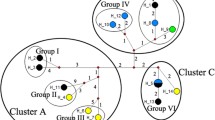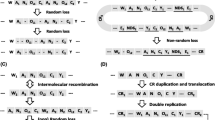Abstract
We describe an unusual repetitive DNA region located in the 3′ end of the light (L)-strand in the mitochondrial control region of two elephant seal species. The array of tandem repeats shows both VNTR (variable-number tandem repeat) and sequence variation and is absent from 12 compared mammalian species, except for the occurrence in the same location of a distinct repetitive region in rabbit mtDNA and a similar repeat in the harbor seal. The sequence composition and arrangement of the repeats differ considerably between the northern elephant seal (Mirounga angustirostris) and the southern species (M. leonina) despite an estimated divergence time of 1 MY (based on an mtDNA-RNA gene and the nonrepetitive control region). Analysis of repeat sequence relationships within and between species indicate that divergence in sequence and structure of repeats has involved both slippagelike and unequal crossingover processes of turnover, generating very high levels of divergence and heteroplasmy.
Similar content being viewed by others
References
Arnason U, Johnsson E (1992) The complete mitochondrial DNA sequence of the harbor seal,Phoca vitulina. J Mol Evol 34:493–505
Bartholemew GA, Hubbs CL (1960) Population growth and seasonal movements of the northern elephant seal,Mirounga angustirostris. Mammalia 24:313–324
Biju-Duval C, Ennafaa H, Dennebouy N, Monnerot M, Mignotte F, Soriguer RC, El Gaaied A, El Hili A, Mounolou J-C (1990) Mitochondrial DNA evolution in lagomorphs: origin of systematic heteroplasmy and organization of diversity in European rabbits. J Mol Evol 33:92–102
Bonnell ML, Selander RK (1974) Elephant seals: genetic variation and near extinction. Science 184:908–909
Boyce TM, Zwick ME, Aquadro CF (1989) Mitochondrial DNA in the bark weevils: size, structure and heteroplasmy. Genetics 123:825–836
Brown WM (1985) The mitochondrial genome of animals. In: MacIntyre RF (ed) Molecular evolutionary genetics. Plenum Press, New York, pp 95–130
Buroker E, Brown JR, Gilbert TA, O'Hara PJ, Beckenbach AT, Thomas WK, Smith MJ (1990) Length heteroplasmy of sturgeon mitochondrial DNA: an illegitimate elongation model. Genetics 124:157–163
Clayton DA (1982) Replication of animal mitochondrial DNA. Cell 28:693–705
Devereux J, Haeberli P, Smithies O (1984) A comprehensive set of sequence analysis programs for the VAX. Nucleic Acids Res 12:387–395
Hancock JM, Dover GA (1988) Molecular coevolution among cryptically simple expansion segments of eukaryotic 26S/28S rRNAs. Mol Biol Evol 5:377–391
Hancock JM, Dover GA (1990) Compensatory slippage in the evolution of ribosomal RNA genes. Nucleic Acids Res 18:5949–5954
Hauswirth WW, Van de Walle MJ, Laipis PJ, Olivo PD (1984) Heterogeneous mtDNA D-loop sequences in bovine tissue. Cell 37:1001–1007
Hoelzel AR, Hancock JM, Dover GA (1991) Evolution of the cetacean mitochondrial D-loop region. Mol Biol Evol 8:475–493
Jeffreys AJ, Wilson V, Thein SL (1985) Hypervariable ‘minisatellite’ regions in human DNA. Nature 314:67–73
Jeffreys AJ, MacLeod A, Tamaki K, Neil DL, Monckton DG (1991) Minisatellite repeat coding as a digital approach to DNA typing. Nature 354:204–209
King JE (1983) Seals of the world. 2nd ed. Cornell University Press, Ithaca, NY
La Roche J, Snyder M, Cook DI, Fuller K, Zouros E (1990) Molecular characterization of a repeat element causing largescale size variation in the mitochondrial DNA of the sea scallopPlacopecten magellanicus. Mol Biol Evol 7:45–64
Levinson G, Gutman GA (1987a) High frequency of short frameshifts in poly-CA/TG tandem repeats borne by bacteriophage M13 inEscherichia coli k-12. Nucleic Acids Res 15:5323–5338
Levinson G, Gutman GA (1987b) Slipped-strand mispairing—a major mechanism for DNA sequence evolution. Mol Biol Evol 4:203–221
Michaels GS, Hauswrith WW, Laipis PJ (1982) Mitochondrial DNA copy number in bovine oocytes and somatic cells. Dev Biol 99:246–251
Mignotte FM, Gueride M, Champagne A-M, Mounolou J-C (1990) Direct repeats in the non-coding region of rabbit mitochondrial DNA: Involvement in the generation of intra and inter-individual heterogeneity. Eur J Biochem 194:561–571
Moritz C, Brown WM (1987) Tandem duplications in animal mitochondrial DNAs: variation in incidence and gene content among lizards. Proc Natl Acad Sci USA 84:7183–7187
Mullis KB, Faloona F (1987) Specific synthesis of DNA in vitro via a polymerase-catalyzed chain reaction. Methods Enzymol 155:355–350
Piko L, Matsumoto L (1976) Number of mitochondria and some properties of mitochondrial DNA in the same egg. Dev Biol 49:1–10
Rand DM, Harrison RG (1989) Molecular population genetics of mtDNA size variation in crickets. Genetics 121:551–569
Saccone C, Attimonelli M, Sbisa E (1987) Structural elements highly preserved during the evolution of the D-loop-containing region in vertebrate mitochondrial DNA. J Mol Evol 26:205–211
Saccone C, Pesole G, Sbisa E (1991) The main regulatory region of mammalian mitochondrial DNA: structure-function model and evolutionary pattern. J Mol Evol 33:83–91
Solignac M, Monnerot M, Mounolou J-C (1986) Concerted evolution of sequence repeats inDrosophila mitochondrial DNA. J Mol Evol 24:53–60
Southern E (1975) Detection of specific sequences among DNA fragments separated by gel electrophoresis. J Mol Biol 98:503
Southern SO, Southern PJ, Dizon AE (1988) Molecular and phylogenetic studies with a cloned dolphin mitochondrial genome. J Mol Evol 28:32–42
Staden R (1982) An interactive graphics program for comparing and aligning nucleic-acid and amino-acid sequences. Nucleic Acids Res 10:2951–2961
Tabor S, Richardson CC (1987) DNA sequence analysis with a modified bacteriophate T7 DNA polymerase. Proc Natl Acad Sci USA 84:4767–4771
Tautz D, Trick M, Dover GA (1986) Cryptic simplicity in DNA is a major source of genetic variation. Nature 322:652–656
Westneat DF, Noon WA, Reeve HK, Aquadro CF (1988) Improved hybridization conditions for DNA ‘fingerprints’ prbed with M13. Nucleic Acids Res 16:161
Wilkinson GS, Chapman AM (1991) Length and sequence variation in evening bat D-loop mtDNA. Genetics 128:607–617
Zuker M, Stiegler P (1981) Optimal computer folding of large RNA sequences using thermodynamics and auxiliary information. Nucleic Acids Res 9:133–148
Zyskind JW, Cleary JM, Brusilow WSA, Harding NE, Smith DW (1983) Chromosomal replication origin from the marine bacteriumVibrio harveyi functions inEscherichia coli oriC consensus sequence. Proc Natl Acad Sci USA 80:1164–1168
Author information
Authors and Affiliations
Rights and permissions
About this article
Cite this article
Hoelzel, A.R., Hancock, J.M. & Dover, G.A. Generation of VNTRs and heteroplasmy by sequence turnover in the mitochondrial control region of two elephant seal species. J Mol Evol 37, 190–197 (1993). https://doi.org/10.1007/BF02407355
Issue Date:
DOI: https://doi.org/10.1007/BF02407355




